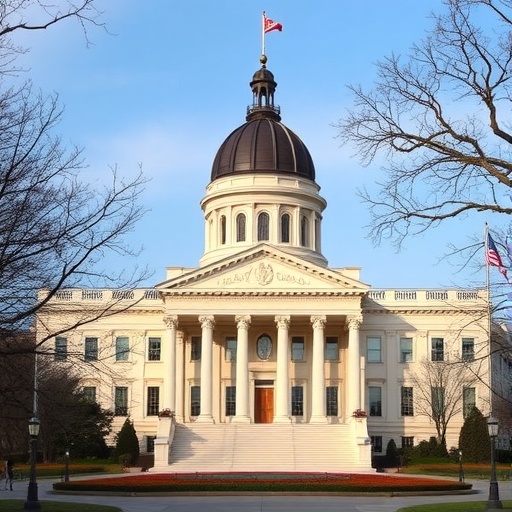Virginia General Assembly Pushes Redistricting Reform Forward in Special Session to Combat Gerrymandering
In a pivotal move that could reshape the Commonwealth’s electoral landscape, the Virginia General Assembly convened a special session on Monday to advance comprehensive redistricting reform measures. This urgent gathering, called by Governor Glenn Youngkin, underscores the growing bipartisan frustration with gerrymandering practices that have long distorted fair representation in the state. As lawmakers debate proposals to establish an independent commission for drawing district lines, Virginia joins a national chorus demanding electoral reform, potentially setting a precedent for other battleground states.
- Lawmakers Rally in Richmond for Urgent Special Session
- Core Proposals Target Gerrymandering’s Grip on Virginia Districts
- Virginia’s Push Aligns with National Surge in Electoral Reform
- Voices from the Ground: Stakeholders Weigh In on Reform Momentum
- Path Ahead: Implications for Virginia’s Political Future
The session kicked off with heated discussions on the floor of the House of Delegates, where delegates from both parties highlighted the need for change. “Virginia’s current system has allowed for maps that favor one party over another, undermining the voice of the people,” said Delegate Chris Jones (R-Suffolk), a key sponsor of the reform bill. With over 80% of Virginians supporting independent redistricting according to a recent poll by the University of Virginia Center for Politics, the pressure is mounting for lawmakers to act decisively.
Lawmakers Rally in Richmond for Urgent Special Session
The special session of the General Assembly was triggered by a confluence of legal challenges and public outcry following the 2020 census data release. Traditionally, redistricting in Virginia has been a partisan affair, with the majority party in the legislature wielding unchecked power to draw boundaries that protect incumbents and dilute minority votes. This year’s effort marks a departure, as a coalition of Republicans and Democrats seeks to neutralize those influences.
Assembly leaders wasted no time diving into the agenda. The session, expected to last up to two weeks, focuses primarily on House Bill 1, which proposes creating a bipartisan advisory commission to recommend district maps. Unlike previous attempts, this bill includes strict criteria for compactness, contiguity, and respect for communities of interest—principles aimed at preventing the snake-like districts infamous in gerrymandering scandals.
Historical context adds weight to the proceedings. Virginia’s redistricting woes date back decades, but they intensified after the 2010 cycle, when Republican-controlled legislatures crafted maps that were later challenged in federal court. In 2018, a U.S. District Court ruled that 11 of the state’s congressional districts were unconstitutionally gerrymandered, forcing a redraw. That ruling, upheld by the Supreme Court in part, exposed the systemic flaws that today’s reformers aim to fix.
Attendance at the session was robust, with over 90 delegates and senators present on day one. Governor Youngkin, in his opening remarks via video, emphasized the session’s importance: “This is about restoring trust in our democracy. Virginia deserves maps drawn for the people, not the politicians.” The governor’s involvement signals strong executive support, which could fast-track the legislation through veto threats if needed.
Core Proposals Target Gerrymandering’s Grip on Virginia Districts
At the heart of the Virginia redistricting debate are specific proposals designed to dismantle gerrymandering‘s hold. The leading bill, HB 1, would establish an independent redistricting commission composed of eight members—four appointed by Democrats and four by Republicans, with no current or former elected officials allowed. This body would solicit public input, use data-driven algorithms for initial drafts, and submit final recommendations to the General Assembly for an up-or-down vote without amendments.
Advocates argue this structure mirrors successful models in states like Michigan and Colorado, where independent commissions have produced more competitive districts. In Michigan, post-reform maps in 2022 led to a 52-13 split in the state House, a far cry from the previous 58-52 Republican edge despite similar vote shares. Virginia could see similar shifts; current congressional districts give Republicans a 7-4 advantage, even though statewide elections are often toss-ups.
Statistics underscore the urgency. A 2023 analysis by the Princeton Gerrymandering Project found that Virginia’s state Senate districts were 15% more packed with one party’s voters than necessary, artificially inflating Republican majorities. On the flip side, Democratic-leaning urban areas like Fairfax County have been splintered across multiple districts to minimize their influence.
Additional elements of the reform package include mandatory public hearings—at least five statewide—and transparency requirements for all mapping software used. “We’ve seen too many backroom deals in the past,” noted Senator Mamie Locke (D-Hampton), co-chair of the Senate Privileges and Elections Committee. “This commission ensures sunlight on the process, giving Virginians a real say.”
Opposition, though muted, comes from some entrenched legislators who fear losing safe seats. Delegate Rob Bell (R-Charlottesville) expressed concerns about the commission’s potential for gridlock, warning that “partisan appointees might just perpetuate the same divides.” Despite this, the bill has garnered 60 co-sponsors in the House, suggesting broad support.
Virginia’s Push Aligns with National Surge in Electoral Reform
Virginia’s special session is not an isolated event but part of a broader national trend toward electoral reform. Over the past five years, 10 states have adopted independent redistricting commissions, driven by grassroots movements and court rulings. Organizations like the National Democratic Redistricting Committee and FairVote have poured resources into these efforts, with Virginia emerging as a key target due to its swing-state status.
Compare this to North Carolina, where aggressive gerrymandering has kept Republicans in control of the legislature despite Democrats winning more votes in recent gubernatorial races. A 2024 federal lawsuit there seeks to invalidate maps on racial grounds, echoing Virginia’s past battles. Meanwhile, Ohio voters approved a 2021 ballot measure banning partisan gerrymandering, reducing the GOP’s supermajority from 66-33 to 64-35 in the state House.
Experts predict Virginia’s reforms could influence the 2026 midterms profoundly. Dr. Larry Sabato, director of the University of Virginia Center for Politics, commented, “If Virginia enacts this, it could flip two or three congressional seats, making the state even more pivotal in national elections.” Nationally, the Brennan Center for Justice reports that gerrymandering has cost Democrats 16 House seats since 2010—equivalent to flipping the chamber’s control.
The federal angle adds complexity. With the Supreme Court’s 2019 Rucho v. Common Cause decision declining to intervene in partisan gerrymandering, states like Virginia are left to self-regulate. This has spurred innovation; California’s independent commission, in place since 2008, has drawn maps that foster competition in 40% of districts, up from 20% pre-reform.
Public engagement is another hallmark of the national movement. In Virginia, over 5,000 residents submitted comments during preliminary hearings last fall, with 70% favoring independent oversight. Groups like OneVirginia2021, which collected 100,000 signatures for a 2020 ballot initiative (later struck down on technicalities), continue to mobilize, partnering with national allies like the League of Women Voters.
Voices from the Ground: Stakeholders Weigh In on Reform Momentum
The General Assembly‘s actions have elicited a spectrum of reactions from stakeholders across Virginia. Civil rights organizations, such as the ACLU of Virginia, hail the session as a victory for democracy. “This is a direct response to decades of discriminatory mapping that suppressed Black votes in places like Richmond and Norfolk,” said Executive Director Claire G. Gastanaga. Data supports this: In the 2020 cycle, gerrymandered districts in the Fifth Congressional District diluted minority influence by 12%, per a Southern Poverty Law Center report.
Business leaders also back the reforms, viewing fair districts as essential for stable governance. The Virginia Chamber of Commerce issued a statement praising the special session: “Predictable electoral outcomes without manipulation will attract investment and foster bipartisanship on economic issues.” Tech firms in Northern Virginia, home to a burgeoning innovation hub, worry that skewed representation hampers policies on cybersecurity and education funding.
Critics, including some conservative think tanks like the Thomas Jefferson Institute, argue the commission could introduce bias through its appointment process. “Appointing members based on party lines might not eliminate politics—it could just relocate them,” said policy director Michael Van Grinsven. However, proponents counter with evidence from Arizona, where a similar commission has operated without major scandals since 2000.
Voter turnout data further bolsters the case for change. In gerrymandered districts, participation drops by up to 8%, according to a MIT study, as voters feel their votes don’t count. Virginia’s 2021 elections saw turnout hit 62%—a record—but advocates say independent redistricting could push it higher by making every race competitive.
Local voices add emotional depth. In rural Southwest Virginia, where districts often snake to include urban pockets for partisan gain, residents like farmer Elena Ramirez told reporters, “My community’s issues—farming subsidies, opioid crisis—get lost in these twisted maps. Reform means our stories finally matter.” Urban dwellers in Alexandria echo this, frustrated by splits that separate neighborhoods from their natural representatives.
Path Ahead: Implications for Virginia’s Political Future
As the special session progresses, the stakes for Virginia redistricting could not be higher. If HB 1 passes, implementation would begin immediately for the 2030 census cycle, with interim maps drawn by the commission for any 2026 adjustments. This timeline aligns with federal requirements, ensuring compliance while giving Virginians time to adapt.
Potential roadblocks include Senate filibusters or gubernatorial amendments, but bipartisan momentum suggests approval by session’s end. Governor Youngkin has pledged to sign the bill, potentially with tweaks for rural protections. Legal experts anticipate challenges from losing parties, but precedents favor reform.
Looking nationally, success in Virginia could inspire holdout states like Texas and Florida, where gerrymandering remains rampant. The For the People Act, a federal electoral reform bill stalled in Congress, draws from state models like Virginia’s—highlighting independent commissions and voting rights safeguards.
Ultimately, these reforms promise a more equitable democracy. By curbing gerrymandering, Virginia could see increased competition, higher turnout, and policies reflecting diverse voices. As Delegate Jones put it, “This isn’t just about lines on a map—it’s about lines of trust between government and the governed.” With the nation watching, Virginia’s special session may well redefine American elections for the better.
Stay tuned for updates as the General Assembly deliberates, with votes expected by week’s end. For more on how these changes could affect your district, check local election resources or contact your representatives.









